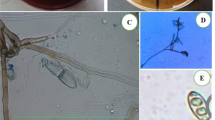Abstract
The studies were carried out at the Federal Agrarian Scientific Center of the Northeast during the period from 2013 to 2017 and in 2019. Model experiments tested seventeen chemical and biological preparations for the ability to limit the germination of sclerotia of the fungus Claviceps purpurea Fr. Tul. The dynamics of growth of mycelium of the fungus Spacelia segetum Lev. have been studied in paired microbial associations (in vitro). The experiments had three replications, and in vitro studies had four replications. The highest biological efficacy was found in the new Turion fungicide, which averaged 90% for 3 years. The Bunker, Dividend Star, and Vitazit preparations showed quite high efficacy (70–80%). In these variants, sclerotia that preserved their viability formed 2–6 stroma with fruiting bodies, while they formed 3–27 stroma in the control variant. Among biofungicides, Pseudobacterine had the highest efficacy (69%). Despite the same active ingredient, all preparations were found to significantly differ in antibiotic properties; therefore, the work with fungicides is individual. A series of laboratory experiments revealed a marked and prolonged antagonism in the biosystem Spacelia segetum–Streptomyces hygroscopicum, strain А-4. The sterile area around S. hygroscopicum averaged 1.95 cm2 for all isolates. It was maintained after 14 days of incubation of the test culture, which makes this strain promising for the construction of a new target biopreparation. Weak inhibition in growth of S. segetum colonies was found in the presence of the fungus Acremoniella occulta and the bacterium Flavobacterium fulvii, strain L-30.
Similar content being viewed by others
REFERENCES
Sheshegova, T.K., Shchekleina, L.M., Zhelifonova, V.P., Antipova, T.V., Baskunov, B.P., and Kozlovskii, A.G., Resistance to ergot in rye cultivars and the content of ergot alkaloids in sclerotia of Claviceps purpurea in Kirov oblast, Mikol. Fitopatol., 2019, vol. 53, no. 3, pp. 177–182. https://doi.org/10.1134/S0026364819030127
Rukshan, L.V., Ergot and rye: Facts and perspectives. https://www.rusnauka.com/23_WP_2009/Agricole/51-109.doc.htm. Accessed December 18, 2019.
Trufanov, O., Lokhov, V., and Rodriges, I., Ergot alkaloids: Current state of the problem and methods of prevention of poisoning, Eksklyusivn. Tekhnol., 2009, no. 6, pp. 50–55. https://www.ergotism.info/ru/2009_trufanov_ergot_alkaloids.pdf. Accessed August 5, 2019.
Pazoutova, S., Olsovska, J., Linka, M., Kolínska, R., and Flieger, M., Chemoraces and habitat specialization of claviceps purpurea populations, Appl. Environ. Microbiol., 2000, vol. 66, pp. 5419–5425.
Miedaner, Tr. and Geiger, H.H., Biology, genetics and manogement of ergot (Claviceps spp.) in rye, sorghum and pearl mille, Toxins, 2015, vol. 7, pp. 659–778.
Dusemund, B., Altmann, H., and Jampen, A., Mutterkornalkaloide in lebensmitteln: Toxikologische Bewerfung: Mutterkorn – alkaloig – kontaminierter roggenmehl, J. Verbraucherschutz Lebensmittelsicherh., 2006, no. 1, pp. 150–152.
Miedaner, T., Mirdita, V., and Geiger, H.H., Strategies in breeding for ergot (Claviceps purpurea) resistance, Book of Abstracts: International Symposium on Rye Breeding & Genetics, Minsk: Belarus, 2010.
Sysuev, V.A., Saitov, V.E., Farafonov, V.G., Suvo-rov, A.N., and Saitov, A.V., Theoretical background of calculating of the parameters of the device for grain cleaning from ergot sclerotia, Russ. Agric. Sci., 2017, vol. 43, no. 3, pp. 273–276.
Frauenstein, K., Bedeutung der Fruchtfolge für den Mutterkornbefall des Roggens, Taf. Ber., 1988, no. 621, pp. 271–273.
Dabkyavichyus, Z.V., Biology of ergot in cereal grasses and control measures, Sb. Tr. Lit. NII Zemled., 1984, no. 53, pp. 85–92.
Nemkovich, A.I., How to protect winter rye crops from ergot?, Akhova Raslin, 1999, no. 2, p. 22.
Buga, S.F., A retrospective analysis of the effectiveness of winter grain seed disinfectants used in the Republic of Belarus, Akhova Raslin, 2002, no. 4, pp. 17–20.
Khaziev, A.Z., Effect of seed chemical treatment on ergot infestation in winter crops, Nauchnye osnovy tekhnologii proizvodstva sel’skokhozyaistvennoi produktsii: Materialy respublikanskoi nauchno-prakticheskoi konferentsii molodykh uchenykh (Scientific Bases of Agricultural Production Technologies: Proc. Republican Scientific-Practical Conference of Young Scientists), Kazan, 2008, pp. 52–58.
The State Catalog of Pesticides and Agrochemicals Approved for Use on the Territory of the Russian Federation. Part 1. Pesticides, Moscow: Minist. Sel’sk. Khoz. Ross. Fed., 2019. http://www.gumat.ru/news/vyshla novaya redaktsiya gosudarstvennogo kataloga pestitsidov i agrokhimikatov-2018.html. Accessed October 29, 2019.
Author information
Authors and Affiliations
Corresponding author
Ethics declarations
The authors declare that they have no conflict of interest. This article does not contain any studies involving animals or human participants performed by any of the authors.
Additional information
Translated by L. A. Solovyova
About this article
Cite this article
Sheshegova, T.K., Shchekleina, L.M. Control of Ergot (Claviceps purpurea (Fr) Tul.) with New Pesticides. Russ. Agricult. Sci. 46, 472–475 (2020). https://doi.org/10.3103/S1068367420050183
Received:
Revised:
Accepted:
Published:
Issue Date:
DOI: https://doi.org/10.3103/S1068367420050183




